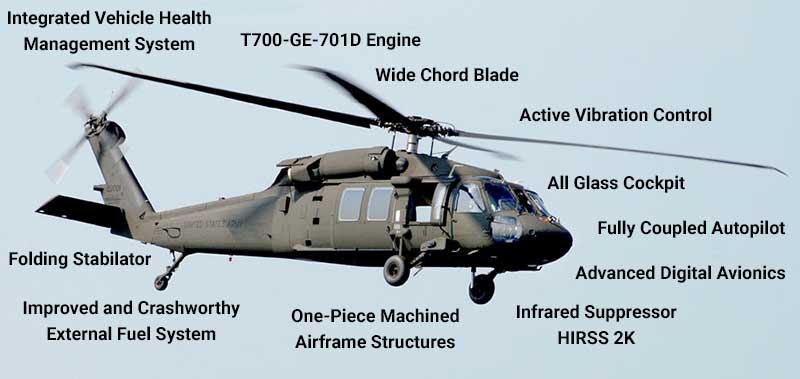Understanding the Mechanics and Design Behind Uh 60 Helicopters
The UH-60 helicopter, frequently recognized as the Black Hawk, stands as a pinnacle of contemporary rotorcraft modern technology, embodying a blend of durable design and detailed mechanics. As we peel back the layers of the UH-60's style, a globe of intricate systems and precise engineering comes to light.
Background of UH-60 Helicopters
The background of UH-60 helicopters traces back to the late 1970s when the USA Army sought a innovative and functional utility helicopter to replace its aging fleet. In response to this demand, the Sikorsky Airplane Company established the UH-60 Black Hawk helicopter. Introduced in 1979, the UH-60 promptly ended up being a staple in armed forces operations as a result of its excellent abilities.
The UH-60 was designed to master a selection of objectives, including army transport, clinical emptying, electronic war, and special procedures. Its capability to adjust to various roles made it a beneficial possession to the U.S. uh 60. Military and other military pressures worldwide
Over the years, the UH-60 system has undertaken several upgrades and variants to enhance its efficiency and equal progressing mission demands. These helicopters have actually seen considerable service in disputes such as the Gulf Battle, Afghanistan, and Iraq, showcasing their dependability and convenience in diverse operational settings. The UH-60's rich history is a testimony to its enduring tradition as a top utility helicopter.

Engine and Power Systems
Making use of sophisticated propulsion innovation, UH-60 helicopters are geared up with advanced engine and power systems to make certain ideal performance and integrity in a variety of operational situations. The UH-60, frequently known as the Black Hawk, is powered by 2 General Electric T700-GE-701D engines, each with the ability of delivering up to 1,940 shaft horse power. These turboshaft engines offer the essential drive for the helicopter to perform its goals efficiently, consisting of troop transportation, medical discharge, and battle assistance.

Blades System and The Rules Of Aerodynamics
Exactly how do the rotor system and the rules of aerodynamics of UH-60 helicopters contribute to their functional effectiveness and flight capacities? The blades system of the UH-60 helicopter plays a vital function in offering lift and propulsion. The UH-60 includes a four-bladed, completely articulated blades system that permits high maneuverability and security during trip. This style enables the helicopter to execute a large range of goals, from transport and clinical evacuation to deal with operations.
Aerodynamics additionally play an essential duty in the performance of UH-60 helicopters. The streamlined body and blades blade design lower drag, allowing the helicopter to accomplish greater rates and much better gas performance. The aerodynamic style of the UH-60 additionally adds to its capacity to operate in diverse ecological problems, including high altitudes and warm temperature levels.
Avionics and Trip Control Systems

In its intricate control with the blades system and the rules of aerodynamics of UH-60 helicopters, the avionics and trip control systems form an essential network of technologies shaping the airplane's functional abilities. In the UH-60, these systems include digital display screens, interaction radios, GPS navigation, climate radar, and auto-pilot systems.
The flight this hyperlink control systems of the UH-60 are responsible for converting the pilot's inputs right into the appropriate adjustments to the you could look here blades system, making sure stable trip and ability to move. These systems include hydraulic actuators, servos, and computer systems that interact to regulate the tail and major blades, as well as various other flight control surface areas. By exactly taking care of the helicopter's trip dynamics, these systems allow pilots to carry out a wide variety of missions, from transport and search-and-rescue to combat procedures, with accuracy and confidence.
Duty and Applications in Air Travel
Avionics systems in UH-60 helicopters incorporate an array of digital systems that help in navigating, communication, tracking, and managing various aircraft features. These systems consist of electronic display screens, auto-pilot systems, interaction radios, GPS navigation equipment, and climate radar. In addition, these systems include security functions such as autopilot settings, terrain awareness warning systems, and security augmentation systems to enhance the total safety and operational capacities of the UH-60 helicopters in different missions, consisting of army transport, clinical emptying, search and rescue, and airborne firefighting.
Final Thought
In final thought, internet the UH-60 helicopter is a versatile aircraft with an abundant history and progressed design. Its engine and power systems, rotor system, the rules of aerodynamics, avionics, and trip control systems all work with each other to make it a efficient and reputable machine.
In its elaborate control with the rotor system and aerodynamics of UH-60 helicopters, the avionics and flight control systems create a vital network of technologies shaping the airplane's functional capabilities.The flight control systems of the UH-60 are accountable for converting the pilot's inputs right into the appropriate modifications to the blades system, making certain stable flight and maneuverability. Avionics systems in UH-60 helicopters incorporate a range of electronic systems that aid in navigation, interaction, tracking, and regulating various aircraft functions. In addition, these systems include security attributes such as auto-pilot settings, surface recognition warning systems, and stability enhancement systems to boost the total safety and security and functional capacities of the UH-60 helicopters in numerous goals, consisting of troop transport, medical evacuation, search and rescue, and aerial firefighting.
Its engine and power systems, blades system, the rules of aerodynamics, avionics, and trip control systems all function together to make it a effective and reputable maker.